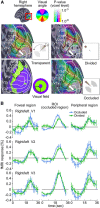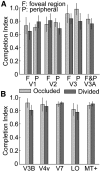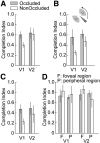Topographic representation of an occluded object and the effects of spatiotemporal context in human early visual areas
- PMID: 24155304
- PMCID: PMC6618442
- DOI: 10.1523/JNEUROSCI.1455-12.2013
Topographic representation of an occluded object and the effects of spatiotemporal context in human early visual areas
Abstract
Occlusion is a primary challenge facing the visual system in perceiving object shapes in intricate natural scenes. Although behavior, neurophysiological, and modeling studies have shown that occluded portions of objects may be completed at the early stage of visual processing, we have little knowledge on how and where in the human brain the completion is realized. Here, we provide functional magnetic resonance imaging (fMRI) evidence that the occluded portion of an object is indeed represented topographically in human V1 and V2. Specifically, we find the topographic cortical responses corresponding to the invisible object rotation in V1 and V2. Furthermore, by investigating neural responses for the occluded target rotation within precisely defined cortical subregions, we could dissociate the topographic neural representation of the occluded portion from other types of neural processing such as object edge processing. We further demonstrate that the early topographic representation in V1 can be modulated by prior knowledge of a whole appearance of an object obtained before partial occlusion. These findings suggest that primary "visual" area V1 has the ability to process not only visible or virtually (illusorily) perceived objects but also "invisible" portions of objects without concurrent visual sensation such as luminance enhancement to these portions. The results also suggest that low-level image features and higher preceding cognitive context are integrated into a unified topographic representation of occluded portion in early areas.
Figures














Similar articles
-
Decoding information about dynamically occluded objects in visual cortex.Neuroimage. 2017 Feb 1;146:778-788. doi: 10.1016/j.neuroimage.2016.09.024. Epub 2016 Sep 20. Neuroimage. 2017. PMID: 27663987 Free PMC article.
-
The neural representation of objects formed through the spatiotemporal integration of visual transients.Neuroimage. 2016 Nov 15;142:67-78. doi: 10.1016/j.neuroimage.2016.03.044. Epub 2016 Mar 24. Neuroimage. 2016. PMID: 27033688 Free PMC article.
-
Attention Priority Map of Face Images in Human Early Visual Cortex.J Neurosci. 2018 Jan 3;38(1):149-157. doi: 10.1523/JNEUROSCI.1206-17.2017. Epub 2017 Nov 13. J Neurosci. 2018. PMID: 29133433 Free PMC article.
-
Representation of Naturalistic Image Structure in the Primate Visual Cortex.Cold Spring Harb Symp Quant Biol. 2014;79:115-22. doi: 10.1101/sqb.2014.79.024844. Epub 2015 May 5. Cold Spring Harb Symp Quant Biol. 2014. PMID: 25943766 Free PMC article. Review.
-
Crowding: a cortical constraint on object recognition.Curr Opin Neurobiol. 2008 Aug;18(4):445-51. doi: 10.1016/j.conb.2008.09.008. Epub 2008 Oct 27. Curr Opin Neurobiol. 2008. PMID: 18835355 Free PMC article. Review.
Cited by
-
Decoding Visual fMRI Stimuli from Human Brain Based on Graph Convolutional Neural Network.Brain Sci. 2022 Oct 15;12(10):1394. doi: 10.3390/brainsci12101394. Brain Sci. 2022. PMID: 36291327 Free PMC article.
-
What, if anything, can be considered an amodal sensory dimension?Psychon Bull Rev. 2024 Oct;31(5):1915-1933. doi: 10.3758/s13423-023-02447-3. Epub 2024 Feb 21. Psychon Bull Rev. 2024. PMID: 38381301 Free PMC article. Review.
-
A detailed theory of thalamic and cortical microcircuits for predictive visual inference.Sci Adv. 2025 Feb 7;11(6):eadr6698. doi: 10.1126/sciadv.adr6698. Epub 2025 Feb 5. Sci Adv. 2025. PMID: 39908384 Free PMC article.
-
Decoding information about dynamically occluded objects in visual cortex.Neuroimage. 2017 Feb 1;146:778-788. doi: 10.1016/j.neuroimage.2016.09.024. Epub 2016 Sep 20. Neuroimage. 2017. PMID: 27663987 Free PMC article.
-
Brain Functional Representation of Highly Occluded Object Recognition.Brain Sci. 2023 Sep 29;13(10):1387. doi: 10.3390/brainsci13101387. Brain Sci. 2023. PMID: 37891756 Free PMC article.
References
Publication types
MeSH terms
LinkOut - more resources
Full Text Sources
Other Literature Sources
